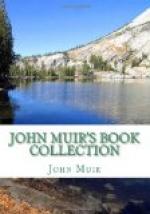Deer also are occasionally met in the canon, making their way to the river when the wells of the plateau are dry. Along the short spring streams beavers are still busy, as is shown by the cotton-wood and willow timber they have cut and peeled, found in all the river drift-heaps. In the most barren cliffs and gulches there dwell a multitude of lesser animals, well-dressed, clear-eyed, happy little beasts—wood-rats, kangaroo-rats, gophers, wood-mice, skunks, rabbits, bob cats, and many others, gathering food, or dozing in their sun-warmed dens. Lizards, too, of every kind and color are here enjoying life on the hot cliffs, and making the brightest of them brighter.
Nor is there any lack of feathered people. The golden eagle may be seen, and the osprey, hawks, jays, humming-birds, the mourning-dove, and cheery familiar singers—the black-headed grosbeak, robin, bluebird, Townsend’s thrush, and many warblers, sailing the sky and enlivening the rocks and bushes through all the canon wilderness.
Here at Hance’s river camp or a few miles above it brave Powell and his brave men passed their first night in the canon on their adventurous voyage of discovery thirty-three years ago. They faced a thousand dangers, open or hidden, now in their boats gladly sliding down swift, smooth reaches, now rolled over and over in back-combing surges of rough, roaring cataracts, sucked under in eddies, swimming like beavers, tossed and beaten like castaway drift—stout-hearted, undaunted, doing their work through it all. After a month of this they floated smoothly out of the dark, gloomy, roaring abyss into light and safety two hundred miles below. As the flood rushes past us, heavy-laden with desert mud, we naturally think of its sources, its countless silvery branches outspread on thousands of snowy mountains along the crest of the continent, and the life of them, the beauty of them, their history and romance. Its topmost springs are far north and east in Wyoming and Colorado, on the snowy Wind River, Front, Park, and Sawatch ranges, dividing the two ocean waters, and the Elk, Wasatch, Uinta, and innumerable spurs streaked with streams, made famous by early explorers and hunters. It is a river of rivers—the Du Chesne, San Rafael, Yampa, Dolores, Gunnison, Cotchetopa, Uncompahgre, Eagle, and Roaring rivers, the Green and the Grand, and scores of others with branches innumerable, as mad and glad a band as ever sang on mountains, descending in glory of foam and spray from snow-banks and glaciers through their rocky moraine-dammed, beaver-dammed channels. Then, all emerging from dark balsam and pine woods and coming together, they meander through wide, sunny park valleys, and at length enter the great plateau and flow in deep canons, the beginning of the system culminating in this grand canon of canons.




